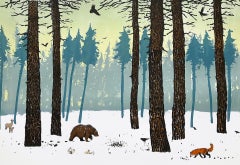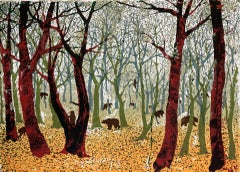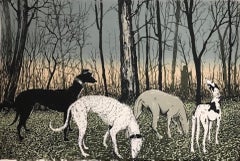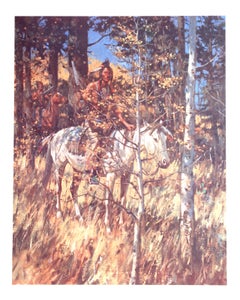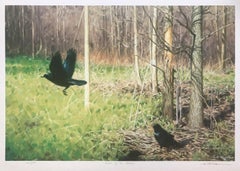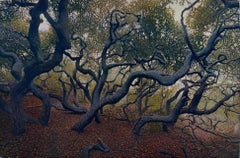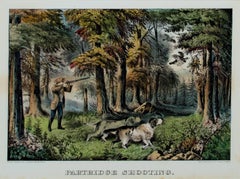Woodland Animal Prints
to
4
2
6
3
4
Overall Width
to
Overall Height
to
9
6
3
1
1
1
5
10
1
13
2
2,737
2,717
1,740
1,451
1,084
860
565
493
456
421
402
357
353
316
253
218
191
174
148
146
10
4
4
3
3
8
7
Art Subject: Woodland
Tim Southall, Winter Woods, Limited Edition Print, Affordable Art, Landscape Art
By Tim Southall
Located in Deddington, GB
Tim Southall
Winter Woods
Limited Edition Screen print
Size: H 40cm x W 60cm
Sold Unframed
(Please note that in situ images are purely an indication of how a piece may look).
Winter...
Category
21st Century and Contemporary Contemporary Landscape Prints
Materials
Paper, Screen
Bears in the Woods, Art Print, Dogs, Animals, Folk, Blue Affordable art
By Tim Southall
Located in Deddington, GB
‘Bears in the Woods’ is a playful silkscreen print depicting a number bears going about their business in autumnal woods. This 6 colour silkscreen is printed on Somerset Velvet, a he...
Category
2010s Contemporary Animal Prints
Materials
Paper, Screen
Tim Southall, Out with the Dogs, Limited Edition Print, Animal Art, Art Online
By Tim Southall
Located in Deddington, GB
Tim Southall
Out with the Dogs
Limited Edition Print
6 colour silkscreen made on Somerset tub size, a heavyweight 350 gram handmade paper
Tim Southall was born in Staffordshire in 1...
Category
21st Century and Contemporary Contemporary Animal Prints
Materials
Paper, Screen
Camouflage, American Western Art Lithograph by Duane Bryers
By Duane Bryers
Located in Long Island City, NY
Duane Bryers, American (1911 - 2012) - Camouflage, Year: 1979, Medium: Lithograph, Signed and Numbered in Pencil, Edition: 300, AP, Image Size: 22.5 x 18 in., Size: 26.5 in. x 2...
Category
1970s American Realist Animal Prints
Materials
Lithograph
CROWS BY THE WOODS
Located in Aventura, FL
Lithograph on paper. Hand signed, titled and numbered by the artist. Edition of 350.
Artwork is in excellent condition. Certificate of Authenticity is included. All reasonable o...
Category
Late 20th Century Realist Figurative Prints
Materials
Paper, Lithograph
Tim Southall, Deer in Winter, Contemporary Etching, Animal Print, Affordable Art
By Tim Southall
Located in Deddington, GB
Tim Southall
Deer in Winter
Limited Edition Etching
Edition of 75
Image Size: H 20cm x W 30cm
Sheet Size: H 35cm x W 42cm x D 0.1cm
Sold Unframed
(Please note that in situ images are...
Category
21st Century and Contemporary Contemporary Landscape Prints
Materials
Paper, Etching
Meadow-Limited Edition Etching, Signed by Artist
By Russa Graeme
Located in Clinton Township, MI
Limited Edition Etching (125/200). Signed by Artist. Measures 32.75 x 25.5 inches and is unframed. The piece is in Fair/Distressed Condition-discoloration/yellowing primarily in the ...
Category
Late 20th Century Landscape Prints
Materials
Etching
Gemsbok Herd
By Zack Seckler
Located in New York, NY
Archival pigment print
Signed and numbered, verso
26.7 x 40 inches
(Edition of 10)
40 x 60 inches
(Edition of 5)
53.3 x 80 inches
(Edition of 3)
This artwork is offered by Clamp...
Category
2010s Contemporary Landscape Photography
Materials
Archival Pigment
Botswana Bath
By Zack Seckler
Located in New York, NY
Archival pigment print
Signed and numbered, verso
26.7 x 40 inches
(Edition of 10)
40 x 60 inches
SOLD OUT.
48 x 72 inches
(Edition of 3)
This artwork is offered by ClampArt, located in New York City.
Please note that prices increase as editions sell.
Zack Seckler's series, “Botswana,” is comprised of a series of exquisite aerial photographs taken in the Kalahari basin in south central Africa between 2009 and 2010. The body of work offers a quite different and almost magical view of the much-photographed and iconic landscape. In order to be able to capture these breathtaking images, Seckler enlisted the services of an expert pilot who flew a small, ultra-lightweight aircraft at low altitudes under...
Category
Early 2000s Contemporary Landscape Photography
Materials
Archival Pigment
On the Tow Path, Animal Art, Landscape Print, English Countryside Print
By Tim Southall
Located in Deddington, GB
Tim Southall – A quiet, reflective image of a forgotten time. This 10 colour silkscreen is printed on Somerset Velvet, a heavyweight 300 gram handmade paper from St Cuthbert’s Mill i...
Category
2010s Contemporary Landscape Prints
Materials
Paper, Screen
Tim Southall, Deer in Winter, Contemporary Etching, Animal Print, Affordable Art
By Tim Southall
Located in Deddington, GB
Tim Southall
Deer in Winter
Limited Edition Etching
Edition of 75
Image Size: H 20cm x W 30cm
Sheet Size: H 35cm x W 42cm x D 0.1cm
Sold Unframed
(Please note that in situ images are...
Category
21st Century and Contemporary Naturalistic Landscape Prints
Materials
Paper, Etching
Mark A Pearce, Olive Grove with Deer, Landscape Art, Affordable Art Online
By Mark Pearce
Located in Deddington, GB
Mark A Pearce
Olive Grove with Deer
Limited Edition Reduction Linocut
Edition of 60
Size: H 44cm x W 71cm x D 0.1cm
Sold Unframed
Please note that in situ images are purely an indica...
Category
21st Century and Contemporary Contemporary Landscape Prints
Materials
Paper, Linocut
Natal IV
By Zack Seckler
Located in New York, NY
Archival pigment print
Signed and numbered, verso
26.7 x 40 inches
(Edition of 10)
40 x 60 inches
(Edition of 5)
53.3 x 80 inches
(Edition of 3)
This artwork is offered by Clamp...
Category
2010s Contemporary Landscape Photography
Materials
Archival Pigment
A FINE SPRING DAY
Located in Aventura, FL
Lithograph on paper. Hand signed, titled and numbered by the artist. Edition of 350.
Artwork is in excellent condition. Certificate of Authenticity is included. All reasonable o...
Category
Late 20th Century Realist Figurative Prints
Materials
Paper, Lithograph
DEER IN A CLEAR CUT
Located in Aventura, FL
Lithograph on paper. Hand signed, titled and numbered by the artist. Edition of 350.
Artwork is in excellent condition. Certificate of Authenticity is included. All reasonable o...
Category
Late 20th Century Realist Figurative Prints
Materials
Paper, Lithograph
Related Items
Meditation and Minou
By Will Barnet
Located in Buffalo, NY
Artist: Will Barnet, American (1911 - 2012)
Title: Meditation and Minou
Year: 1980
Medium: Lithograph and Serigraph on BFK Rives, signed and numbered in pencil
Edition: 40/150
Category
1970s American Realist Figurative Prints
Materials
Archival Paper, Lithograph
Monkey - Lithograph by Alberto Mastroianni - 1970s
Located in Roma, IT
Monkey is an original artwork realized by Alberto Mastroianni in 1970 ca.
Lithograph.
Hand Signed.
Edition of 150 pieces.
Category
1970s Contemporary Figurative Prints
Materials
Paper, Lithograph
H 27.17 in W 11.03 in D 0.04 in
Gazelle - Lithograph by A. Mastroianni - 1970s
Located in Roma, IT
Hand Signed. Edition of 150 prints in Arabic numbers plus 30 prints in roman numbers.
Excellent conditions.
Category
1970s Realist Animal Prints
Materials
Lithograph
H 27.56 in W 11.03 in D 0.04 in
Early Speed
Located in Fairlawn, OH
Early Speed
Lithograph, 1953
Signed lower right
Edition 250
Published by Associated American Artists
Illustrated: AAA catalog 1953-03
Reference: AAA Index 1187
Condition: The sheet i...
Category
1950s American Realist Animal Prints
Materials
Lithograph
Horsemen
Located in San Francisco, CA
This artwork titled "The Horsemen" 1935, is an original lithograph on paper by noted American artist William Gropper, 1897-1977. It is hand signed in pencil by the artist. The artwork (image) size is 9.5 x 12.75 inches, framed size is 17.5 x 20.40 inches. Published by Associated American Artists, New York, printed by George Miller. Referenced and pictured in the artist catalogue raisonne by Steinberg, page 246 and Windisch and Cole, plate #602. Custom framed in a black metal frame, with off white matting. It is in excellent condition, the frame have very minor scratches.
An example of this particular artwork is held at the Metropolitan Museum of Art, New York. and at the Portland Museum, Portland.
About the artist:
William Gropper was born in New York City's Lower East Side in 1897. He was the first of six children to parents who earned small wages working in sweatshops. At the age of fourteen, Gropper left school to help support his family. While carrying bolts of cloth for his deliveries, Gropper began to draw on scraps of paper, sidewalks, and walls. A passerby saw some of these drawings and invited Gropper to attend a life-drawing class at the Ferrer School. He studied there for three years from 1912 to 1915, attending classes taught by Robert Henri and George Bellows. From 1915 to 1918 Gropper attended the New York School of Fine and Applied Art part-time on scholarship. Gropper also won a scholarship to the National Academy of Design, but remained as a student for only a short time; the rigid and systematic institution conflicted with Gropper's belief in the personal nature of art.
At the New York School of Fine and Applied Art, Gropper earned several prizes. One of these prizes was for his cartoons, which led him to be hired by the New York Tribune in 1917 to sketch for their features. A few years later through freelance work, his cartoons and drawings appeared in other newspapers and magazines, such as The Liberator, The New Masses, The New York Post, The New Yorker and Vanity Fair.
By the late 1920s Gropper was an established cartoonist and draughtsman. He sympathized with the labor movement and was a champion of peace and personal liberty. Gropper began to paint seriously, but privately, on these themes in 1921. Gropper's first exhibition of monotypes was held in 1921 at the Washington Square Book Shop in New York. At this time, he also began to do illustrations for books. Gropper took his first sketching trip in 1924 to the West with Morris Pass.
By 1930 Gropper began to receive recognition as a fine artist. In 1934, he received two mural commissions from the Schenley Corporation in New York City. In 1935, he was commissioned to paint a mural for the Hotel Taft in New York City. In 1936, Gropper received several public mural commissions: one was for the Freeport, Long Island Post Office, which was completed in 1938 and followed by another mural for the Northwestern Postal Station, Detroit, Michigan.
In his first gallery exhibition in 1936 at ACA Galleries, Gropper's work was so well received by critics, collectors, and artists that the following year he had two one-man exhibitions at ACA Galleries. In 1937, Gropper traveled west on a Guggenheim Fellowship and visited the Dust Bowl and the Hoover and Grand Coulee Dams, sketching studies for a series of paintings and a mural he painted for the Department of the Interior in Washington, DC. That same year he had paintings purchased by both the Metropolitan Museum of Art and the Museum of Modern Art.
Gropper exhibited at the 1939 New York World's Fair, Whitney Museum of American Art (1924-55), Art Institute of Chicago (1935-49), Carnegie International (1937-50), Pennsylvania Academy of the Fine Arts (1939-48), and National Academy of Design (1945-48). He was a founder of the Artists Equity Association and member of the National Institute of Arts and Letters.
From 1940 to 1945 William Gropper was preoccupied with anti-Nazi cartoons...
Category
Mid-20th Century American Realist Figurative Prints
Materials
Lithograph
Eyvind Earle 'Three Horses' Limited Edition Signed Serigraph Print
By Eyvind Earle
Located in San Rafael, CA
Eyvind Earle (1916-2000)
Three Horses (Version 2), 1987
Serigraph in colors on black wove paper
Edition 46/100
Signed and editioned in blue pencil along lower edge
21 1/4 x 40- /8 in...
Category
Late 20th Century Contemporary Landscape Prints
Materials
Screen
H 30.5 in W 49.5 in D 2.5 in
Soaking Up
Located in San Francisco, CA
This artwork titled "Soaking Up" c.1970 is an original lithograph on Wove paper by noted western artist Tom (Thomas) Ryan, 1922-2011. It is hand signed, titled and numbered 68/100 in pencil by the artist. The artwork (image) size is 12.25 x 17.35 inches, sheet size is 17.5 x 21.65 inches. It is in excellent condition
About the artist:
Tom Ryan was born Jan. 12, 1922, in Springfield, Ill., to William Martin Ryan — whose family immigrated to Illinois from Ireland in the 1880s — and Sarah Helen Behrens, whose ancestry predates the Revolutionary War. They had nine children — six boys and three girls. He began drawing before he went to school.
"I was 4 years old and drawing airplanes, and an older brother was helping me," Ryan told the Reporter-Telegram in a 2002 interview at the Haley Library's going away party held in his honor. "Those were my first art lessons."
He did not decide to be an artist until after his service in World War II. While in the U.S. Navy during the war, he "made quite a bit of money" drawing portraits of his shipmates and other servicemen. After being discharged in 1945, he picked up a Life magazine that carried an article about N.C. Wyeth.
"I read the article, and I liked what I read, and I loved the pictures reproduced from his paintings in the article," Ryan said in 2002. "I decided then and there to be an artist."
Following his graduation from the American Academy of Art, an education made possible through the GI Bill, he returned to Springfield where he married Jacqueline "Jacquie" Harvey, daughter of a local doctor. She died in 1998.
The Ryans moved to New York City where he continued his studies at the Art Students League. During his second year at the Art Students League, he won a contest. His winning painting became the cover for Western writer Ernest Haycox's novel The Outlaw.
"Every month after that I also received an assignment from this publisher, and they would be Western novels," Ryan said in 2002. "So that's what I did for the next six or seven years. Then I started exhibiting at the Latendorf Gallery on Madison Avenue. What I sold mainly were the book covers. They would be published and I would get paid by the publisher, and I'd take them to the gallery, and I'd get paid again."
Ryan began making trips west in the late 1950s. He would stay three or four months painting, sketching and photographing scenes he'd need later. At that time, his works centered around historical events and places.
"I particularly liked to do some of the trail drive things that I did, like the old longhorns," Ryan said in 2002.
In the early 1960s, a work by Norman Rockwell and one by Ryan appeared in the same catalog. Rockwell, who was doing the Boy Scouts calendars for Brown and Bigelow, the premiere calendar publishing company in the United States, told the calendar company about Ryan.
"The art director gave me a call and asked if I'd like to do a contemporary cowboy...
Category
Late 20th Century American Realist Figurative Prints
Materials
Lithograph
SINGLIN' OUT Signed Lithograph, Rocky Mountain Landscape, Cowboy, Horses
Located in Union City, NJ
SINGLIN' OUT by the American Western artist Conrad Schwiering, is a hand drawn limited edition lithograph printed using hand lithography techniques on archival Somerset paper 100% acid free. SINGLIN' OUT is a realistic Western landscape scene set in Wyoming with a backdrop of Wyoming's majestic purple gray Grand Teton mountains...
Category
1980s American Realist Animal Prints
Materials
Lithograph
Portrait of an Artist as Cat-hand painted #1 of 3 Proof-British Awarded Artist
Located in London, GB
This stunning Artist's Proof is an one-off, oil hand-painted and charcoal drawn by the artist , signed at front and on the back label too; each proof is 80% hand painted and drawn by...
Category
2010s Contemporary Animal Prints
Materials
Gesso, Archival Ink, Acrylic, Oil, Archival Paper, Giclée
H 39.38 in W 27.56 in D 0.04 in
"INDIAN ON HORSE" WESTERN NATIVE AMERICAN
Located in San Antonio, TX
Olaf Wieghorst
(1899 - 1988)
California, New York, New Mexico, Arizona, Texas Artist
Image Size: 11 x 8.5
Frame Size: 18.5 x 14.5
Medium: Print
"Indian on Horse...
Category
20th Century Realist Figurative Prints
Materials
Archival Pigment
EASIN' EM HOME Signed Lithograph, Western Scene, Cowboy Crossing River, Horses
Located in Union City, NJ
EASIN' EM HOME by the American Western artist Conrad Schwiering, is a hand drawn limited edition lithograph(not a photo reproduction or digital print) printed using hand lithography ...
Category
1980s American Realist Animal Prints
Materials
Lithograph
SHOE SHOP Signed Lithograph, Cowboy Farrier, Horseshoe, White Horse, Western Art
Located in Union City, NJ
SHOE SHOP by the American Western artist Conrad Schwiering, is a hand drawn limited edition lithograph(not a photo reproduction or digital print) printed using hand lithography techn...
Category
1980s American Realist Animal Prints
Materials
Lithograph
Previously Available Items
Elfin Forest, by Stephen McMillan
Located in Palm Springs, CA
Medium: etching and aquatint
Edition of 200
Year: 2019
Image Size: 6 x 9 inches
Signed, titled and numbered by the artist.
The Elfin Forest is a grove of pygmy live oak trees just s...
Category
2010s Contemporary Landscape Prints
Materials
Etching, Aquatint
"Partridge Shooting, " Original Color Lithograph Landscape by Currier & Ives
Located in Milwaukee, WI
"Partridge Shooting" is an original color lithograph by Currier & Ives. It depicts a hunter shooting a partridge and his dogs rushing to retrieve it. The figure and animals are in a dense forest.
11" x 14" art
19 3/4" x 23" frame
Nathaniel Currier was a tall introspective man with a melancholy nature. He could captivate people with his piercing stare or charm them with his sparkling blue eyes. Nathaniel was born in Roxbury, Massachusetts on March 27th, 1813, the second of four children. His parents, Nathaniel and Hannah Currier, were distant cousins who lived a humble yet spartan life. When Nathaniel was eight years old, tragedy struck. Nathaniel’s father unexpectedly passed away leaving Nathaniel and his eleven-year-old brother Lorenzo to provide for the family. In addition to their mother, Nathaniel and Lorenzo had to care for six-year-old sister Elizabeth and two-year-old brother Charles. Nathaniel worked a series of odd jobs to support the family, and at fifteen, he started what would become a life-long career when he apprenticed in the Boston lithography shop of William and John Pendleton.
A Bavarian gentleman named Alois Senefelder invented lithography just 30 years prior to young Nat Currier’s apprenticeship. While under the employ of the brothers Pendleton, Nat was taught the art of lithography by the firm’s chief printer, a French national named Dubois, who brought the lithography trade to America.
Lithography involves grinding a piece of limestone flat and smooth then drawing in mirror image on the stone with a special grease pencil. After the image is completed, the stone is etched with a solution of aqua fortis leaving the greased areas in slight relief. Water is then used to wet the stone and greased-ink is rolled onto the raised areas. Since grease and water do not mix, the greased-ink is repelled by the moisture on the stone and clings to the original grease pencil lines. The stone is then placed in a press and used as a printing block to impart black on white images to paper.
In 1833, now twenty-years old and an accomplished lithographer, Nat Currier left Boston and moved to Philadelphia to do contract work for M.E.D. Brown, a noted engraver and printer. With the promise of good money, Currier hired on to help Brown prepare lithographic stones of scientific images for the American Journal of Sciences and Arts. When Nat completed the contract work in 1834, he traveled to New York City to work once again for his mentor John Pendleton, who was now operating his own shop located at 137 Broadway. Soon after the reunion, Pendleton expressed an interest in returning to Boston and offered to sell his print shop to Currier. Young Nat did not have the financial resources to buy the shop, but being the resourceful type he found another local printer by the name of Stodart. Together they bought Pendleton’s business.
The firm ‘Currier & Stodart’ specialized in "job" printing. They produced many different types of printed items, most notably music manuscripts for local publishers. By 1835, Stodart was frustrated that the business was not making enough money and he ended the partnership, taking his investment with him. With little more than some lithographic stones, and a talent for his trade, twenty-two year old Nat Currier set up shop in a temporary office at 1 Wall Street in New York City. He named his new enterprise ‘N. Currier, Lithographer’
Nathaniel continued as a job printer and duplicated everything from music sheets to architectural plans. He experimented with portraits, disaster scenes and memorial prints, and any thing that he could sell to the public from tables in front of his shop. During 1835 he produced a disaster print Ruins of the Planter's Hotel, New Orleans, which fell at two O’clock on the Morning of the 15th of May 1835, burying 50 persons, 40 of whom Escaped with their Lives. The public had a thirst for newsworthy events, and newspapers of the day did not include pictures. By producing this print, Nat gave the public a new way to “see” the news. The print sold reasonably well, an important fact that was not lost on Currier.
Nat met and married Eliza Farnsworth in 1840. He also produced a print that same year titled Awful Conflagration of the Steamboat Lexington in Long Island Sound on Monday Evening, January 18, 1840, by which melancholy occurrence over One Hundred Persons Perished. This print sold out very quickly, and Currier was approached by an enterprising publication who contracted him to print a single sheet addition of their paper, the New York Sun. This single page paper is presumed to be the first illustrated newspaper ever published.
The success of the Lexington print launched his career nationally and put him in a position to finally lift his family up. In 1841, Nat and Eliza had their first child, a son they named Edward West Currier. That same year Nat hired his twenty-one year old brother Charles and taught him the lithography trade, he also hired his artistically inclined brother Lorenzo to travel out west and make sketches of the new frontier as material for future prints. Charles worked for the firm on and off over the years, and invented a new type of lithographic crayon which he patented and named the Crayola. Lorenzo continued selling sketches to Nat for the next few years.
In 1843, Nat and Eliza had a daughter, Eliza West Currier, but tragedy struck in early 1847 when their young daughter died from a prolonged illness. Nat and Eliza were grief stricken, and Eliza, driven by despair, gave up on life and passed away just four months after her daughter’s death.
The subject of Nat Currier’s artwork changed following the death of his wife and daughter, and he produced many memorial prints and sentimental prints during the late 1840s. The memorial prints generally depicted grief stricken families posed by gravestones (the stones were left blank so the purchasers could fill in the names of the dearly departed). The sentimental prints usually depicted idealized portraits of women and children, titled with popular Christian names of the day.
Late in 1847, Nat Currier married Lura Ormsbee, a friend of the family. Lura was a self-sufficient woman, and she immediately set out to help Nat raise six-year-old Edward and get their house in order. In 1849, Lura delivered a son, Walter Black Currier, but fate dealt them a blow when young Walter died one year later. While Nat and Lura were grieving the loss of their new son, word came from San Francisco that Nat’s brother Lorenzo had also passed away from a brief illness. Nat sank deeper into his natural quiet melancholy. Friends stopped by to console the couple, and Lura began to set an extra place at their table for these unexpected guests. She continued this tradition throughout their lives.
In 1852, Charles introduced a friend, James Merritt Ives, to Nat and suggested he hire him as a bookkeeper. Jim Ives was a native New Yorker born in 1824 and raised on the grounds of Bellevue Hospital where his father was employed as superintendent. Jim was a self-trained artist and professional bookkeeper. He was also a plump and jovial man, presenting the exact opposite image of his new boss.
Jim Ives met Charles Currier through Caroline Clark, the object of Jim’s affection. Caroline’s sister Elizabeth was married to Charles, and Caroline was a close friend of the Currier family. Jim eventually proposed marriage to Caroline and solicited an introduction to Nat Currier, through Charles, in hopes of securing a more stable income to support his future wife.
Ives quickly set out to improve and modernize his new employer’s bookkeeping methods. He reorganized the firm’s sizable inventory, and used his artistic skills to streamline the firm’s production methods. By 1857, Nathaniel had become so dependent on Jims’ skills and initiative that he offered him a full partnership in the firm and appointed him general manager. The two men chose the name ‘Currier & Ives’ for the new partnership, and became close friends.
Currier & Ives produced their prints in a building at 33 Spruce Street where they occupied the third, fourth and fifth floors. The third floor was devoted to the hand operated printing presses that were built by Nat's cousin, Cyrus Currier, at his shop Cyrus Currier & Sons in Newark, NJ. The fourth floor found the artists, lithographers and the stone grinders at work. The fifth floor housed the coloring department, and was one of the earliest production lines in the country. The colorists were generally immigrant girls, mostly German, who came to America with some formal artistic training. Each colorist was responsible for adding a single color to a print. As a colorist finished applying their color, the print was passed down the line to the next colorist to add their color. The colorists worked from a master print displayed above their table, which showed where the proper colors were to be placed. At the end of the table was a touch up artist who checked the prints for quality, touching-in areas that may have been missed as it passed down the line. During the Civil War, demand for prints became so great that coloring stencils were developed to speed up production.
Although most Currier & Ives prints were colored in house, some were sent out to contract artists. The rate Currier & Ives paid these artists for coloring work was one dollar per one hundred small folios (a penny a print) and one dollar per one dozen large folios. Currier & Ives also offered uncolored prints to dealers, with instructions (included on the price list) on how to 'prepare the prints for coloring.' In addition, schools could order uncolored prints from the firm’s catalogue to use in their painting classes.
Nathaniel Currier and James Merritt Ives attracted a wide circle of friends during their years in business. Some of their more famous acquaintances included Horace Greeley, Phineas T. Barnum, and the outspoken abolitionists Rev. Henry Ward, and John Greenleaf Whittier (the latter being a cousin of Mr. Currier).
Nat Currier and Jim Ives described their business as "Publishers of Cheap and Popular Pictures" and produced many categories of prints. These included Disaster Scenes, Sentimental Images, Sports, Humor, Hunting Scenes, Politics, Religion, City and Rural Scenes, Trains, Ships, Fire Fighters, Famous Race Horses, Historical Portraits, and just about any other topic that satisfied the general public's taste. In all, the firm produced in excess of 7500 different titles, totaling over one million prints produced from 1835 to 1907.
Nat Currier retired in 1880, and signed over his share of the firm to his son Edward. Nat died eight years later at his summer home 'Lion’s Gate' in Amesbury, Massachusetts. Jim Ives remained active in the firm until his death in 1895, when his share of the firm passed to his eldest son, Chauncey.
In 1902, faced will failing health from the ravages of Tuberculosis, Edward Currier sold his share of the firm to Chauncey Ives...
Category
1870s Other Art Style Animal Prints
Materials
Lithograph
